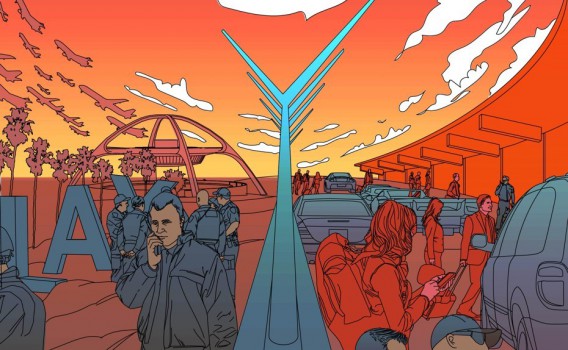















January 10, 2017 | permalink

BLDGBLOG and A Burglar’s Guide to the City author Geoff Manaugh has a deep, deep dive in The Atlantic into LAX’ homegrown counter-terrorism intelligence unit, one designed to both thwart potential threats and collect intelligence on passengers passing through the United States’ single largest entrepot.
Geoff interviewed me for BLDGBLOG when Aerotropolis was published in 2011, and I in turn interviewed him for FSG’s Work in Progress. So he was kind enough to call me for some context on LAX and how it fits into the global network of trade and movement that really defines the world:
Greg Lindsay is coauthor of the 2011 book Aerotropolis: The Way We’ll Live Next, written with University of North Carolina business consultant John Kasarda. Seen through Lindsay’s eyes, aviation logistics takes on near-psychedelic dimensions. When someone looks at a map of the world, he or she might take in superficial details, like the outlines of nation-states, but Lindsay sees tax-free supply-chain hubs, special economic zones, and transnational land deals. Individual airports, he pointed out, are complexly knit together through global-service contracts and preferred air routes that often defy straightforward geopolitical explanations. What’s more, the value of consumer goods that pass through the LAX-to-Tokyo or LAX-to-Shanghai air corridors often exceeds the GDPs of many nation-states–yet those invisible routes, despite their outsize economic influence, don’t show up on world maps.
The fact that an airport such as LAX would begin to realize its true power and economic stature in the world is not at all surprising for Lindsay–nor, of course, is it news to anyone that airports are increasingly terrorist targets. A piece of infrastructure turning into its own intelligence-gathering apparatus, Lindsay suggested, is just “the natural trickle-down effect of when, after 9/11, the NYPD expanded its own intelligence efforts, deciding that the FBI, CIA, and Homeland Security were simply not good enough. They had to project their own presence.” More to the point, they realized, like LAX, just how much there was to protect–and how badly other people wanted to destroy it.
Today’s threats, whether terrorist or merely criminal, are increasingly networked and dispersed; it only makes sense that an institution’s response to them must take a similar form. It might sound like science fiction, but, in 20 years’ time, it could very well be that LAX has a stronger international-intelligence game than many U.S. allies. LAX field agents could be embedded overseas, cultivating informants, sussing out impending threats. It will be an era of infrastructural intelligence, when airfields, bridges, ports, and tunnels have, in effect, their own internal versions of the CIA–and LAX will be there first.

» Folllow me on Twitter.
» Email me.
» See upcoming events.

Greg Lindsay is a generalist, urbanist, futurist, and speaker. He is a non-resident senior fellow of the Arizona State University Threatcasting Lab, a non-resident senior fellow of MIT’s Future Urban Collectives Lab, and a non-resident senior fellow of the Atlantic Council’s Scowcroft Strategy Initiative. He was the founding chief communications officer of Climate Alpha and remains a senior advisor. Previously, he was an urban tech fellow at Cornell Tech’s Jacobs Institute, where he explored the implications of AI and augmented reality at urban scale.

January 31, 2024
Unfrozen: Domo Arigatou, “Mike 2.0”
January 22, 2024
The Future of Generative AI in Architecture, Engineering, and Construction
January 18, 2024
The Promise and Perils of the Augmented City
January 13, 2024
Henley & Partners: Generative AI, Human Labor, and Mobility

----- | January 22, 2024
The Future of Generative AI in Architecture, Engineering, and Construction
----- | January 1, 2024
----- | August 3, 2023
CityLab | June 12, 2023
Augmented Reality Is Coming for Cities
CityLab | April 25, 2023
The Line Is Blurring Between Remote Workers and Tourists
CityLab | December 7, 2021
The Dark Side of 15-Minute Grocery Delivery
Fast Company | June 2021
Why the Great Lakes need to be the center of our climate strategy
Fast Company | March 2020
How to design a smart city that’s built on empowerment–not corporate surveillance
URBAN-X | December 2019
CityLab | December 10, 2018
The State of Play: Connected Mobility in San Francisco, Boston, and Detroit
Harvard Business Review | September 24, 2018
Why Companies Are Creating Their Own Coworking Spaces
CityLab | July 2018
The State of Play: Connected Mobility + U.S. Cities
Medium | May 1, 2017
Fast Company | January 19, 2017
The Collaboration Software That’s Rejuvenating The Young Global Leaders Of Davos
The Guardian | January 13, 2017
What If Uber Kills Public Transport Instead of Cars
Backchannel | January 4, 2017
The Office of the Future Is… an Office
New Cities Foundation | October 2016
Now Arriving: A Connected Mobility Roadmap for Public Transport
Inc. | October 2016
Why Every Business Should Start in a Co-Working Space
Popular Mechanics | May 11, 2016
Can the World’s Worst Traffic Problem Be Solved?
The New Republic | January/February 2016